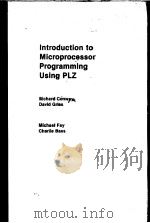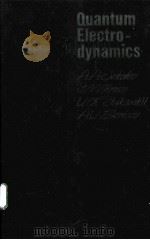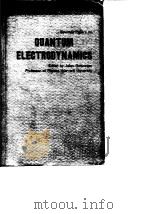《INTRODUCTION TO ELECTRODYNAMICS》
| 作者 | DAVID J. GRIFFITHS 编者 |
|---|---|
| 出版 | PRENTICE-HALL INC |
| 参考页数 | 479 |
| 出版时间 | 没有确切时间的资料 目录预览 |
| ISBN号 | 无 — 求助条款 |
| PDF编号 | 811697048(仅供预览,未存储实际文件) |
| 求助格式 | 扫描PDF(若分多册发行,每次仅能受理1册) |
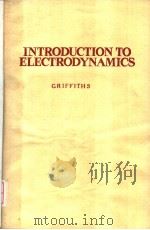
ADVERTISEMENT1
ONEVECTOR ANALYSIS7
1.1VECTOR ALGEBRA7
1.1.1 Vector Operations7
1.1.2 Vector Algebra:Component Form10
1.1.3 Triple Products13
1.1.4 How Vectors Transform14
1.2DIFFERENTIAL CALCULUS16
1.2.1 “Ordinary” Derivatives16
1.2.2 Gradient17
1.2.3 The Operator ▽20
1.2.4 Divergence21
1.2.5 The Curl22
1.2.6 Product Rules24
1.2.7 Second Derivatives26
1.3INTEGRAL CALCULUS28
1.3.1 “Ordinary” Integration28
1.3.2 The Fundamental Theorem for Gradients29
1.3.3 The Fundamental Theorem for Divergences31
1.3.4 The Fundamental Theorem for Curls35
1.3.5 Relations Among the Fundamental Theorems38
1.3.6 Divergence-Less and Curl-Less Fields40
1.4 CURVILINEAR COORDINATES40
1.4.1Spherical Polar Coordinates40
1.4.2 Cylindrical Coordinates45
1.5 THE ROLE OF VECTOR CALCULUS IN ELECTRODYNAMICS46
TWOELECTROSTATICS49
2.1THE ELECTROSTATIC FIELD49
2.1.1 Introduction49
2.1.2 Coulomb’s Law50
2.1.3 The Electric Field51
2.1.4 Continuous Charge Distributions52
2.2DIVERGENCE AND CURL OF ELECTROSTATIC FIELDS56
2.2.1 Field Lines and Gauss’s Law56
2.2.2 The Divergence of E60
2.2.3 Applications of Gauss’s Law61
2.2.4 The Curl of E66
2.3 ELECTRIC POTENTIAL68
2.3.1Introduction to Potential68
2.3.2 Comments on Potential69
2.3.3 Poisson’s Equation and Laplace’s Equation73
2.3.4 Potential of a Charge Distribution74
2.3.5 Summary; Electrostatic Boundary Conditions77
2.4 WORK AND ENERGY IN ELECTROSTATICS79
2.4.1The Work Done in Moving a Charge79
2.4.2 The Energy of a Point Charge Distribution80
2.4.3 The Energy of a Continuous Charge Distribution82
2.4.4 Comme?ts on Electrostatic Energy83
2.5 CONDUCTORS85
2.5.1Basic Properties of Conductors85
2.5.2 Induced Charges87
2.5.3 The Surface Charge on a Conductor; the Force on a Surface Charge90
2.5.4 Capacitors91
THREESPECIAL TECHNIQUES FOR CALCULATING POTENTIALS96
3.1LAPLACE’S EQUATION AND UNIQUENESS THEOREMS96
3.1.1 Introduction96
3.1.2 Laplace’s Equation in One Dimension97
3.1.3 Laplace’s Equation in Two Dimensions98
3.1.4 Laplace’s Equation in Three Dimensions100
3.1.5 Boundary Conditions for Laplace’s Equation101
3.1.6 Conductors and the Second Uniqueness Theorem103
3.2 THE METHOD OF IMAGES106
3.2.1The Classic Image Problem106
3.2.2 The Induced Surface Charge108
3.2.3 Force and Energy108
3.2.4 Other Image Problems109
3.3 SEPARATION OF VARIABLES112
3.3.1Cartesian Coordinates112
3.3.2 Spherical Coordinates121
3.4 MULTIPOLE EXPANSION129
3.4.1Approximate Potential at Large Distances129
3.4.2 The Monopole and Dipole Terms131
3.4.3 Origin of Coordinates in Multipole Expansions133
3.4.4 The Electric Field of a Dipole134
FOURELECTROSTATIC FIELDS IN MATTER138
4.1POLARIZATION138
4.1.1 Dielectrics138
4.1.2 Induced Dipoles139
4.1.3 Alignment of Polar Molecules141
4.1.4 Polarization144
4.2THE FIELD OF A POLARIZED OBJECT144
4.2.1 Bound Charges144
4.2.2 Physical Interpretation of Bound Charge147
4.2.3 The Field Inside a Dielectric150
4.3 THE ELECTRIC DISPLACEMENT152
4.3.1Gauss’s Law in the Presence of Dielectrics152
4.3.2 A Deceptive Parallel155
4.4 LINEAR DIELECTRICS156
4.4.1Susceptibility,Permittivity,Dielectric Constant156
4.4.2 Special Problems Involving Linear Dielectrics161
4.4.3 Force and Energy in Dielectric Systems166
4.4.4 Polarizability and Susceptibility170
FIVEMAGNETOSTATICS174
5.1THE LORENTZ FORCE LAW174
5.1.1 Magnetic Fields174
5.1.2 Magnetic Forces176
5.1.3 Currents180
5.2 THE BIOT-SAVART LAW184
5.2.1Steady Currents184
5.2.2 The Magnetic Field of a Steady Current185
5.3 THE DIVERGENCE AND CURL OF B190
5.3.1Straight-Line Currents190
5.3.2 The Divergence of B192
5.3.3 The Curl of B193
5.3.4 Ampere’s Law194
5.3.5 Comparison of Magnetostatics and Electrostatics201
5.4 MAGNETIC VECTOR POTENTIAL203
5.4.1The Vector Potential203
5.4.2 Summary; Magnetestatic Boundary Conditions208
5.4.3 Multipole Expansion of the Vector Potential210
SIXMAGNETOSTATIC FIELDS IN MATTER218
6.1MAGNETIZATION218
6.1.1 Diamagnets,Paramagnets,Ferromagnets218
6.1.2 Torques and Forces on Magnetic Dipoles219
6.1.3 Effect of Magnetic Field on Atomic Orbits222
6.1.4 Magnetization224
6.2 THE FIELD OF A MAGNETIZED OBJECT225
6.2.1Bound Currents225
6.2.2 Physical Interpretation of Bound Currents227
6.2.3 The Magnetic Field Inside Matter229
6.3 THE AUXILIARY FIELD H230
6.3.1Ampere’s Law in Magnetized Materials230
6.3.2 A Deceptive Parallel233
6.4 LINEAR AND NONLINEAR MEDIA234
6.4.1Magnetic Susceptibility and Permeability234
6.4.2 Ferromagnetism237
SEVENELECTRODYNAMICS243
7.1ELECTROMOTIVE FORCE243
7.1.1 Ohm’s Law243
7.1.2 Electromotive Force250
7.1.3 Motional emf252
7.2FARADAY’S LAW257
7.2.1 Electromagnetic Induction257
7.2.2 Inductance263
7.2.3 Energy in Magnetic Fields268
7.3MAXWELL’S EQUATIONS273
7.3.1 Electrodynamics Before Maxwell273
7.3.2 How Maxwell Fixed Up Ampere’s Law274
7.3.3 Maxwell’s Equations and Magnetic Charge276
7.3.4 Maxwell’s Equations Inside Matter277
7.3.5 Boundary Conditions280
7.4 POTENTIAL FORMULATION OF ELECTRODYNAMICS282
7.4.1Scalar and Vector Pater?ials282
7.4.2 Gauge Transformation?283
7.4.3 Coulomb Gauge and Lorentz Gauge284
7.4.4 Lorentz Force Law in Patential Form286
7.5 ENERGY AND MOMENTUM IN ELECTRODYNAMICS287
7.5.1Newton’s Third Law in Electrodynamics287
7.5.2 Poynting’s Theorem288
7.5.3 Maxwell’s Stress Tensor291
EIGHTELECTROMAGNETIC WAVES295
8.1THE WAVE EQUATION295
8.1.1 Introduction295
8.1.2 The Wave Equation in One Dimension297
8.1.3 Sinusoidal Waves300
8.1.4 Polarization304
8.1.5 Boundary Conditions:Reflection and Transmission306
8.2 ELECTROMAGNETIC WAVES IN NONCONDUCTING MEDIA309
8.2.1Monochromatic Pl???Waves in Vacuum309
8.2.2 Energy and Momentum of Electromagnetic Waves313
8.2.3 Propagation Through Linear Media315
8.2.4 Reflection and Transmission at Normal Incidence316
8.2.5 Reflection and Transmission at Oblique Incidence318
8.3 ?CTROMAGNETIC WAVES IN CONDUCTORS324
8.3.1 The Modified Wave E???tion324
8.3.2 Monochromatic Plane Waves in Conducting Media327
8.3.3 Reflection and Trans???ssion at a Conducting Surface330
8.4 DISPERSION333
8.4.1The Frequency Dependence of ?,μ,and σ333
8.4.2 Dispersion in Nonconductors335
8.4.3 Free Electrons in Conductors and Plasmas340
NINEELECTROMAGNETIC RADIATION345
9.1DIPOLE RADIATION345
9.1.1 Retarded Potentials345
9.1.2 Electric Dipole Radiation350
9.1.3 Magnetic Dipole Radiation356
9.1.4 Radiation from an Arbitrary Distribution of Charges and Currents360
9.2RADIATION FROM A POINT CHARGE365
9.2.1 Lienard-Wiechert Potentials365
9.2.2 The Fields of a Point Charge in Motion370
9.2.3 Power Radiated by a Point Charge375
9.3 RADIATION REACTIQN380
9.3.1The Abraham-Lorentz Formula380
9.3.2 The Physical Origin of the Radiation Reaction384
TENELECTRODYNAMICS AND RELATIVITY388
10.1THE SPECIAL THEORY OF RELATIVITY388
10.1.1 Einstein’s Postulates388
10.1.2 The Geometry of Relativity396
10.1.3 The Lorentz Transformations406
10.1.4 The Structure of Spacetime412
10.2 RELATIVISTIC MECHANICS420
10.2.1Proper Time and Prop?r Velocity420
10.2.2 Relativistic Energy and Momentum422
10.2.3 Relativistic Kinematics426
10.2.4 Relativistic Dynamics430
10.3RELATIVISTIC ELECTRODYNAMICS435
10.3.1 Magnetism as a Relativistic Phenomenon435
10.3.2 How the Fields Transform437
10.3.3 The Field Tensor445
10.3.4 Electrodynamics in Tensor Notation448
10.3.5 Potential Formulation of Relativistic Electrodynamics451
APPENDIX AVECTOR CALCULUS IN CURVILINEAR COORDINATES454
INTRODUCTION454
NOTATION454
GRADIENT455
DIVERGENCE456
CURL458
LAPLACIAN460
APPENDIX BUNITS467
INDEX467
《INTRODUCTION TO ELECTRODYNAMICS》由于是年代较久的资料都绝版了,几乎不可能购买到实物。如果大家为了学习确实需要,可向博主求助其电子版PDF文件(由DAVID J. GRIFFITHS PRENTICE-HALL INC 出版的版本) 。对合法合规的求助,我会当即受理并将下载地址发送给你。
高度相关资料
-

- Introduction To Topology
- 1949 Princeton University Press
-
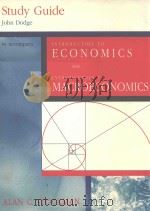
- INTRODUCTION TO ECONOMICS AND INTRODUCTION TO MACROECONOMICS
- 1996 The Dryden Press
-

- QUANTUM ELECTRODYNAMICS
- 1977 GORDON AND BREACH SCIENCE PUBLISHERS
-

- Introduction to Sociology
- 1971 Harold M.Hodges.JR
-

- INTRODUCTION TO GEOMAGNETISM
- 1983 SCOTTISH ACADEMIC PRESS
-
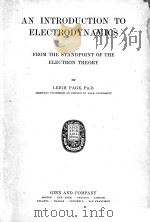
- AN INTRODUCTION TO ELECTRODYNAMICS FROM THE STANDPOINT OF THE ELECTRON THEORY
- 1922 GINN AND COMPANY
-

- Introduction to Chemistry
- 1968 Academic Press Inc.
-
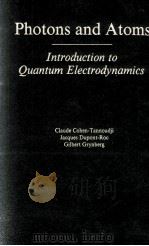
- PHOTONS AND ATOMS: INTRODUCTION TO QUANTUM ELECTRODYNAMICS
- 1989 JOHN WILEY & SONS
-

- INTRODUCTION TO PERFUMERY
- 1994 ELLIS HORWOOD Limited
提示:百度云已更名为百度网盘(百度盘),天翼云盘、微盘下载地址……暂未提供。➥ PDF文字可复制化或转WORD

